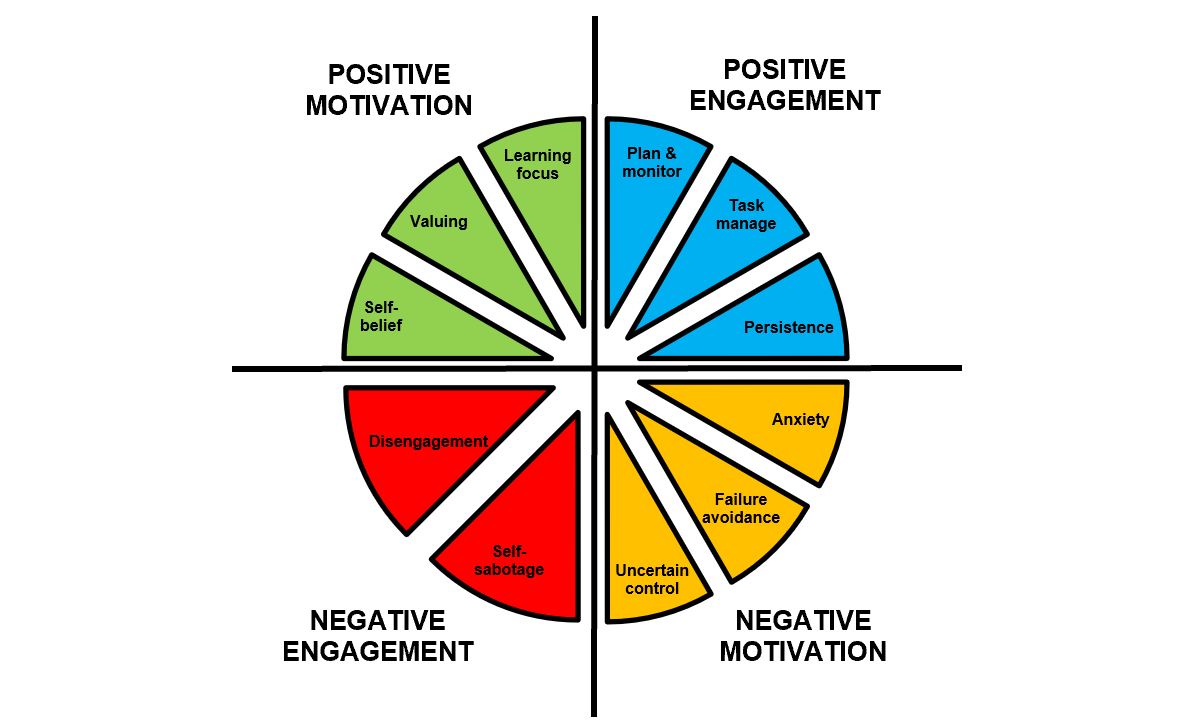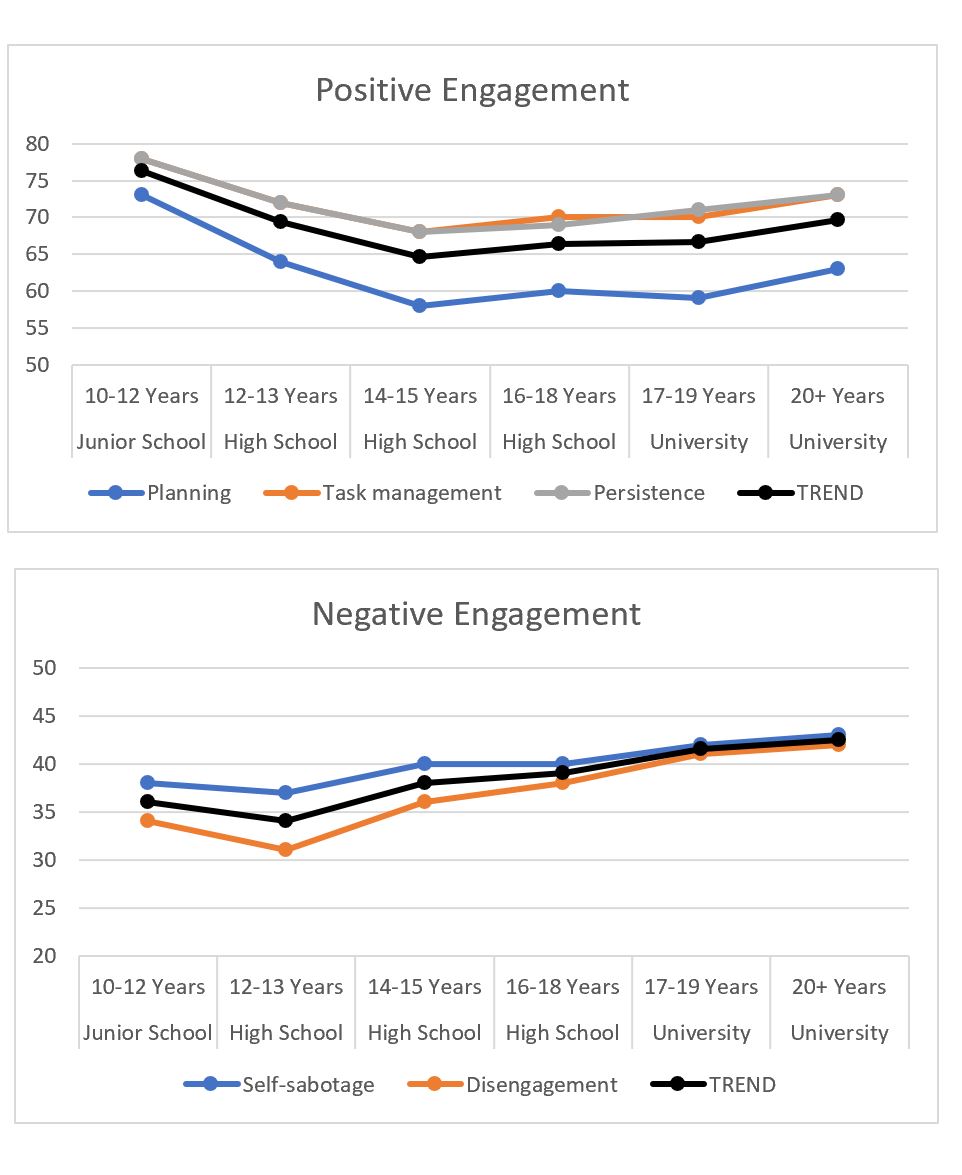Engagement refers to the behaviours and strategies that follow from this energy and drive. Both motivation and engagement play a large part in students’ enjoyment of learning and the quality and extent of that learning.
Many factors contribute to students’ motivation and engagement, including contextual factors such as teachers, parents, and peers.
Personal factors also play a role, including gender and even one’s personality. In this article, the role of age is explored.
Research has shown that students’ motivation and engagement tend to decline as they enter the adolescent years and then pick up again as students move into later adolescence and then early adulthood.
Indeed, major theories of motivation and development also reference this pattern – for example, stage-environment fit theory describes how schools and schooling can be a poor fit with the developmental needs of adolescents and this mismatch contributes to a decline in students’ motivation and engagement.
However, most of this theory and research has tended to focus on school students and particularly their transition to high school. For a more comprehensive consideration of age, it is important to traverse an age range that encompasses primary (elementary) school through to university/college.
Another limitation is that most research has focused mainly on individual aspects of motivation and engagement – for example, only on self-efficacy, or on students’ valuing of learning.
To more fully understand the role of age, it is important to look at a diverse range of motivation and engagement factors. This is where the Motivation and Engagement Wheel is helpful.
The Motivation and Engagement Wheel
The Wheel (below) encompasses eleven positive and negative dimensions of motivation and engagement. All eleven dimensions are relevant to students’ academic development, from primary school through to university/college.

Self-belief refers to students’ belief and confidence in their ability to understand or to do well in their studies, to meet challenges they face, and to perform to the best of their ability.
Valuing is how much students believe that what they learn is useful, relevant, meaningful, and important.
Learning focus refers to students’ focus on learning, developing new skills, improving, and understanding new things – more than being focused on rewards or the marks they will get for their efforts.
Persistence is how much students persevere to work out an answer or to understand a problem, even if it is difficult.
Planning and monitoring is how much students plan homework, assignments, or study – and the strategies they use to keep track of progress.
Task management is how students use their homework or study time, organise a homework or study timetable, and choose and arrange where they do homework or study.
Anxiety comprises feeling nervous and worrying. Feeling nervous refers to the uneasy or sick feeling students get when thinking about or doing their learning tasks, assignments, or tests. Worrying refers to their fear about not doing very well in learning tasks, assignments, or tests.
Uncertain control refers to students feeling uncertain or unsure about how to do well or how to avoid doing poorly.
Failure avoidance occurs when the main reason students apply themselves to learning or assignment tasks is to avoid doing poorly or to avoid letting significant others (e.g., parents) down.
Self-sabotage refers to things students do that reduce their academic success – for example, procrastinating or wasting time when they are meant to be doing homework or studying for a test.
Disengagement refers to feelings and thoughts of giving up, trying less each week, detachment from learning, a sense of helplessness, and little or no involvement in class activities.
The Motivation and Engagement Scale
The Motivation and Engagement Scale is used in schools and universities (e.g., by teachers, lecturers, counsellors, psychologists, researchers) to assess students on each part of the Wheel.
There is a primary/elementary school version (MES – junior school), a high school version (MES – high school), and a university/college version (MES – university/college).
Students answer a set of questions for each part of the Wheel. Students complete the MES online or in hard copy. It takes about 10-15 minutes. There are 11 parts of the Wheel and thus students receive 11 scores.
Scores can be used to develop educational support, provide information to students, educators and parents, or to benchmark classes, year groups or an entire school/faculty.
This article summarises data from the most up-to-date Australian datasets for all three versions of the MES (thus, students from primary school to university/college) drawn from research and assessment conducted over the past two decades.
How do students of different ages compare?
The students comprise 3,303 10-12 year-olds (completing the MES – junior school); 14,321 12-13 year-olds, 15,791 14-15 year-olds, and 11,695 16-18 year-olds (completing the MES – high school); 1,225 17-19 year-olds and 1,335 20+ year-olds (completing the MES – university/college).
In the graphs below are the average scores (out of 100) for students at different ages for each set of positive motivation, positive engagement, negative motivation, and negative engagement factors (for standard deviations, contact the author).
Also in the graphs are trend lines for each set which represent the average score for all factors in that set.


For positive motivation and positive engagement, there is a decline as students move into mid-adolescence and then an incline as they move into late adolescence and early adulthood.
For negative motivation, the overall trend is somewhat steady (though, increasing slightly) across all age groups. That said, anxiety increases markedly across the age groups.
For negative engagement, the trend is up across the age groups, with the largest escalation between early and mid-adolescence.
Summing up
There are clear age trends on these major motivation and engagement factors – but these seem to differ between positive and negative dimensions.
For the positive motivation and engagement dimensions, there is confirmation of the often-reported decline in motivation and engagement as students enter adolescence, but which reverses as students move into late adolescence and then early adulthood.
However, the pattern for negative motivation and engagement is different. Here we see more of an escalation across the academic lifespan, from primary school to university – especially for anxiety, self-sabotage, and disengagement.
This suggests, for example, that the academic anxiety often attributed to the pressures of senior high school continues to manifest in university students’ academic lives.
Practitioners are to be mindful of these age-related differences in different facets of motivation and engagement as they teach and counsel students.
For the positive motivation and engagement factors, it is important to support students through the mid-adolescent years so that they enter late adolescence from as high a base of positive motivation and engagement as possible.
For negative motivation and engagement (especially anxiety), efforts to support students must extend well beyond mid-adolescence –that is, helping students effectively manage anxiety, self-sabotage, and disengagement are an ever-present imperative.
The findings provide direction for practitioners as they aim to address students’ motivational pathways across the academic lifespan – and beyond.
The author's research can be accessed via ResearchGate and his personal URL.
References
Eccles, J.S., Wigfield, A., & Byrnes, J. (2003). Cognitive development in adolescence. In R.M. Lerner., M.A. Easterbrooks., & J. Mistry (Eds). Handbook of psychology: Developmental psychology (pp. 325-350). American Psychological Association. https://doi.org/10.1002/0471264385.wei0613
Liem, G.A., & Martin, A.J. (2012). The Motivation and Engagement Scale: Theoretical framework, psychometric properties, and applied yields. Australian Psychologist, 47, 3-13. https://doi.org/10.1111/j.1742-9544.2011.00049.x
Martin, A.J. (2003). How to motivate your child for school and beyond. Random House/Bantam.
Martin, A.J. (2010). Building classroom success: Eliminating academic fear and failure. Continuum.
Martin, A.J. (1999-2022). The Motivation and Engagement Scale. Lifelong Achievement Group (www.lifelongachievement.com).















